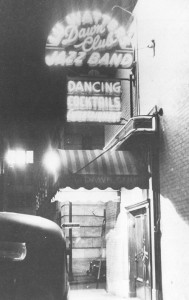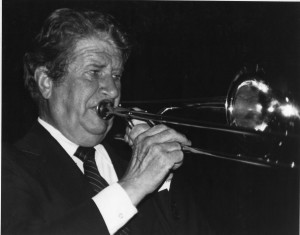They called their music 'The Truth'—real, righteous Traditional Jazz. By the early 1940s its champions were the powerful West Coast brassmen Turk Murphy and Lu Watters.
Disciples of 'The Real Stuff' themselves, The Jim Cullum Jazz Band presents their concert tribute to The West Coast Classic Jazz Revival at the Stanford Jazz Festival in California, this week on Riverwalk Jazz.
West Coast 'true believers' in Traditional Jazz preached their gospel at the Dawn Club on San Francisco’s Annie Street, a little alleyway near the old Palace Hotel. They held forth at Hambone Kelly’s across the Bay and later at the Hangover Club and Earthquake McGoon’s. Beginning in 1939 bandleader and cornetist Lu Watters and trombonist Turk Murphy gave the movement its impetus, and it kept right on rolling across the country well into the 1970s.
These revivalists didn’t learn their stuff only by sitting around listening to scratchy records. They were veteran jazzmen, bored with working in bloated Swing bands playing tangos, fox-trots—and precious little jazz. They were enchanted with the excitement of music from a bygone era. They brought a muscular, inventive approach to the roots of jazz, and made it their own. A second generation continues to this day, including many jazz artists who have appeared on the Riverwalk Jazz radio series in the past 20 years.
The authenticity of Lu Watters’ Yerba Buena Stompers set the group apart from other small, ‘hot’ Swing-oriented ensembles of the era. Both Watters and Murphy were serious students of early jazz. Watters wrote many new arrangements of the old tunes, breathing new life into them. Almost all the tunes in their playbook— "Shake That Thing," "Cakewalkin' Babies From Home," "Froggie Moore Rag," "That's a Plenty" and others—hearkened back to New Orleans and repertoire created by King Oliver, Jelly Roll Morton, W.C. Handy and Clarence Williams. They created originals, too. "Emperor Norton's Hunch" and "Big Bear Stomp" were inspired by people and places in the Bay Area.
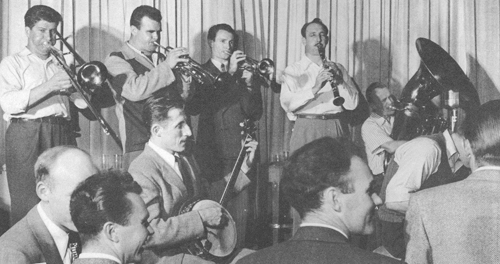
Opening night at Hambone's, San Francisco, 1947. Turk Murphy, Lu Watters on left. Photo by Tom Quinn.
The instrumentation and performance practices of the Yerba Buena band might well be considered 'antique'—the use of banjo instead of guitar, tuba instead of string bass, ragtime piano, snare-drum oriented drumming instead of ride or sock cymbals, and two-to-the-bar bass. The horns produced a rough-edged, blues-drenched sound inspired by King Oliver, Louis Armstrong, Johnny Dodds, Kid Ory and others.
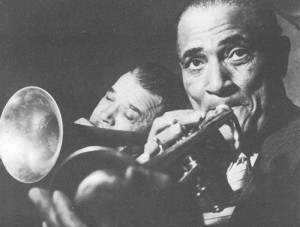
Trumpeter Papa 'Mutt' Carey & Trombonist Kid Ory (rear) of Kid Ory's Creole Jazz Band. Photo courtesy Charles Campbell.
At the heart of the 'West Coast' style was the jazz ensemble—all horns blowing improvised jazz at once, in a spirited conversation. Jim Cullum says, "Like the King Oliver band, the basis of the Yerba Buena Jazz Band was ensemble playing. Lu’s vision drove the band sound." And Jim's extensive use of the jazz ensemble in his own band is a defining quality that sets it apart from others on today's jazz scene.
By the mid-1940s several "originals" of early New Orleans jazz—Bunk Johnson, Papa 'Mutt' Carey, Pops Foster and Kid Ory—settled in San Francisco. Their hot, boisterous and slightly chaotic "ensemble" style of jazz had been all but forgotten with the advent of Swing ten years earlier. The older New Orleans men quickly became the heroes and patron saints of the new Classic Jazz Revival.
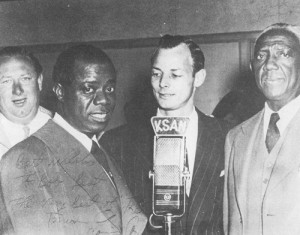
L-R, Bob Est, Louis Armstrong, radio host Ted Lenz, & Bunk Johnson in the KSAN studio. Photo from The Great Jazz Revival by Jim Goggin & Peter Clute.
Lu Watters said the foundation of the traditional jazz he played was dancing. Like his model, King Oliver, who got the crowds up on their feet at Chicago’s Lincoln Gardens, Lu loved to play to a packed dance floor.
Then late at night, after last call, with the tables strewn with empty glasses and the lights low, the Watter's band would wind down with a haunting, slow blues by W. C. Handy—"Friendless Blues," a tune often played today by The Jim Cullum Jazz Band.
Photo credit for Home Page: Ad for Lu Watters & Yerba Beuna Jazz Band at Dawn Club. Image courtesy San Francisco Tradional Jazz Foundation.
Text based on Riverwalk Jazz script by Margaret Moos Pick ©2012


